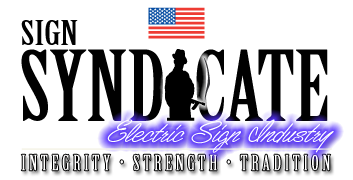-
Posts
127 -
Joined
-
Last visited
-
Days Won
1
Content Type
Profiles
Forums
Events
Blogs
Gallery
Community Map
Everything posted by tdexxx
-

Channel Letter Installation: Remote Power Supplies
tdexxx replied to tdexxx's topic in General Message Board
In addition to serving as a means of bonding the letters, isn't conduit also required by the NEC for the protection of conductors from physical damage? (I know that in the Code the word "protection" almost always refers to overcurrent protection, but in this case we're talking physical protection). Does this requirement for physical protection really exist or am I just imagining it? Maybe led power supply secondary conductors aren't required to be protected by conduit because they're class 2? -
Oops, I don't need to say it twice.
-
Probably less than 10% of the HID lighting repairs I do are ballast replacements, the rest are lamp replacements. 400 and 1000 watt metal halide ballasts running at 208 or 277 volts lamps are most common in parking lots and 100 and 175 watt ballasts running at 120 or 277 volts often are used in hotel/restaurant canopies. When ballasts need replacement, most usually it is the capacitor which has failed; the core&coil part of the ballast very seldom burns out in my experience, even though it is sealed in a small unventilated metal enclosure along with a 400 or 1000 watt bulb. I'd think a big challenge to the development of a 400 or 1000 watt ballast replacement will be dealing with that heat. I don't know if it's possible to make, but a self-ballasted HID bulb, (similar to the self-ballasted CFL), for the canopy lights would be nice. Both installation and service would be lots easier with a self-ballasted lamp.
-

Channel Letter Installation: Remote Power Supplies
tdexxx replied to tdexxx's topic in General Message Board
Interesting. Can anyone confirm that? Actually you need to confirm. I'll explain. UL passes new revisions every three years. However, the municipality is the one that decides IF and WHEN they are going to pass a particular version of UL. That is the deciding factor. I haven't read the current - but I doubt the UL really cares about the protection factor as mentioned by someone - but it might be addressed by the local AHJ. Check out the new Paige wire and the Paige pass thrus. Much faster, cheaper, etc for LeD wiring than using sealtight, conduit, etc. Certain P/s still need to be mounted in trans box, lockabledisconnect cover if inside and out of site, etc - again, depending onAHJ. gn OK. Thanks! -

Channel Letter Installation: Remote Power Supplies
tdexxx replied to tdexxx's topic in General Message Board
Interesting. Can anyone confirm that? -
Hello All, It's been my experience that in led sign installations with remote power supplies, inspectors allow the class 2 power supply wire to run, (in ceiling spaces), between the letters and power supply outside of conduit. I always thought conduit was required for all sign wiring, but inspectors don't seem to object to class 2 wiring being unprotected by conduit. Has the code changed, or do I misunderstand it? Thanks.
-

ground connections for LED channel letters
tdexxx replied to eugene@signmakershc.com's topic in General Message Board
Would it not be a code violation to use a grounding bushing outside of an enclosure? After all, if the bushing is outside of an enclosure, than the ground wire has to be exposed and not protected. Or am I wrong yet again. -

ground connections for LED channel letters
tdexxx replied to eugene@signmakershc.com's topic in General Message Board
I'm likely wrong about this, but I have always assumed that the reason the NEC specifies grounding even for low voltage channel letters isn't because of the potential hazard from stray 12 dc, but rather because the NEC is against the idea of allowing any large potentially electrifiable thing to be ungrounded. -
Hello All. The following question would be better asked of a lawyer, I know, but hoping to leave lawyers out of it, I'll ask here to see if anyone has had similar experience and can offer advice. A local Signarama for which I have done contracting in the past has been taken over and the former managers for whom I did contract work have been ousted. The former managers were, I believe, not the actual franchise owners, and the people who took over management are and have been the actual franchise owners. Regarding outstanding payments owed to me for work commissioned by former managers, the franchise owners tell me to pursue the former managers for the money owed. But that seems pretty useless, after all if I couldn't collect them when they were running the Signarama how much luck will I have now that they're no longer associated with the business? The amount in question is less than two thousand dollars. I'm wondering two things about this: do the franchise owners, (who allowed the old managers to DBA Signarama), really have no legal obligation to pay my outstanding bills, and would I have legitimate grounds to file a mechanic's lien against the franchise owners? Any help will be appreciated. Tom
-
I was just wondering about the "diffusor" singface material that I have run across in several channel letter signs. It looks like a paper-thin opaque seeming layer with a matrix of tiny perforations that let some of the light through, and it's placed over a white plastic signface. What is the purpose of that stuff, and what is its intended effect?
-
Action Services is the new name of Action National, and they have been around a while and are pretty well known. In my own experience they're not bad to work with. They have always paid me. It has taken me up to 90 days to get paid, though. But overall, they seem ok.
-
If a sign shop employee is a pot user in California and has a medical marijuana card, and that person loses his or her job as the result of testing positive on a drug screening, then I wonder if that person has cause to sue under the Americans with Disabilities Act?
-
Mechanic's Liens: anyone out there have knowledge of them? How do they work? If a contracting agency subcontracts some work and then goes out of business before paying the subcontractor, can the subcontractor file a lien against the improved property? Thanks, Tom
-
Hello All, Here's a quick question about the repair of LED channel letter signs. Can I successfully replace one manufacturer's power supply with a different brand of power supply as long as both units have the same labeled output voltage and output wattage? Do these power supplies self-regulate so that one labeled as a 90 watt can be go in place of a failed power supply labeled 60 watts, (assuming the rated voltages of the two units match?) Thanks, Tom
-
Cabinet neon signs with peanut housings and raceway mounted channel letter signs that use short runs of exposed gto only and no long runs or grounded conduit would seem to be good candidates for using ssts rather than magnetic transformers, especially when it comes to repair since access to sign components can be hard. Will an sst perform as well as a magnetic in this type of sign? Tom
-
Are the electronic transformers that are built for use inside channel letters, (like the Ventex models), really good enough to be considered as alternatives to magnetic transformers in those signs? I repair signs in the field which means that I replace transformers, and it would be easy for me to install a new SST in place of a burned out magnetic because of the electronic's smaller size, lighter weight, and lesser expense. But do SSTs last as long or work as reliably as magnetics? Tom
-
I should have specified message centers. Tom
-
Through my company I've offered neon bending and bucket truck sign repair services for some years, but I haven't had much experience with led-illuminated signs and displays. Since they have become so popular, I'd like to learn to repair them too, but I'm not sure where to start. Anybody have any advice for someone wanting to teach himself about led sign repair?
-
Maintenx http://www.mainten-x.com/ Starlite Sign http://www.starlitesign.com/index2.cfm Advanced Power Technologies http://www.advancedpowertech.com/
-

Deadbeat National Sign / Lighting Companies *List*
tdexxx replied to Erik Sine's topic in General Message Board
This is a great idea. Let's build up a list of the good national contractors. But we should probably do it in a new thread instead of in this one, since the name of this one would be misleading. So I'll start up a new thread called Reliable National Sign Companies. Please come post the names of companies that have treated you well. I do occasional work for one company that has been fair with me, and I'll post it in the new thread. Tom -
Hello All, Last year I finally got around to listing my neon/sign service business in the yellow pages, and since then I have been contacted by a few out-of-state maintenance companies who have offered me sub-contract work in my geographical area. Does anyone have any general advice as to how to make the most of this kind of relationship or any warnings about these companies? One specific question I have regards the "Not To Exceed", (NTE), amounts that these companies send me along with their work orders. I know this NTE is the maximum I'm supposed to bill. Is the NTE effectively the amount that the company really expects to pay the contractor; that is, should I consider billing the company a lesser amount than the NTE to be leaving money on the table? Thanks, Tom
-

Deadbeat National Sign / Lighting Companies *List*
tdexxx replied to Erik Sine's topic in General Message Board
That's my understanding of the law here in NC too. Ours is traditionally and historically a politically conservative state, and so business tends to be less extensively regulated than it might be in parts of the northeast or the west coast. Tom -

Deadbeat National Sign / Lighting Companies *List*
tdexxx replied to Erik Sine's topic in General Message Board
In my state, North Carolina, I'm not aware of any rule that says a company contracting out sign installation work must hold any kind of license at all. It is required here that a company pulling a sign permit be licensed, (which means that the company has a licensed contractor on staff), and it's the permit puller's responsibility that the installation comply with regulations and pass inspection. In fact I know of several small sign companies that started out selling banners that have expanded into channel letter signs. They order their electric signs from fabricators, accept delivery, and sub contract the installation to companies like mine that are licensed and can pull a sign permit. All they really do is sell the signs. -

Deadbeat National Sign / Lighting Companies *List*
tdexxx replied to Erik Sine's topic in General Message Board
Interesting that you post on this particular topic. I was just contacted by a Florida maintenance company to do some local sign repair, and since this is the first time I have been contracted by such a company, I was wondering if anyone could offer any advice on how to deal with them. Hopefully, I won't soon be adding to this deadbeat company's list.


